| Columns Retired Columns & Blogs |
... a wide variety of speakers, perhaps every Stereophile reviewer should own one of these amps to serve as a fixed point of reference when reviewing other equipment.
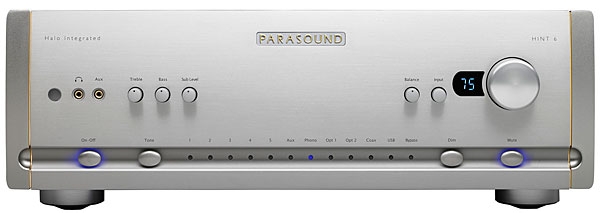
I hoped to hear the Halo Integrated for myself. So when, for the March 2019 issue, I reviewed the Spendor Audio Systems A7 loudspeaker, which requires more power than my 20Wpc Shindo Laboratory Haut-Brion amp can muster, I requested a loaner. Parasound sent me the revised version, the Halo Hint 6, with a revised list price of $2995—a $500 increase.
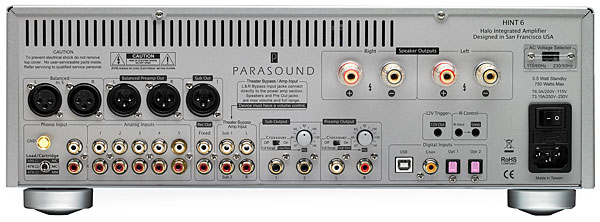
Phil Jackson, Parasound's product and sales specialist, explained via e-mail: "New changes from the original Halo Integrated include a Burr-Brown, analog resistor-ladder volume control; dimmable front-panel volume display; updated uPnP USB receiver; an additional optical input (two total); ball-bearing–supported, solid-aluminum volume knob; programmable default volume setting; 'favorite volume memory' with remote-control button; increased phono-stage gain of 7dB (from 35dB to 42dB) for lower-output MM cartridges; improved left/right channel separation and balance tracking; and updated cosmetics with subtle gold highlights."
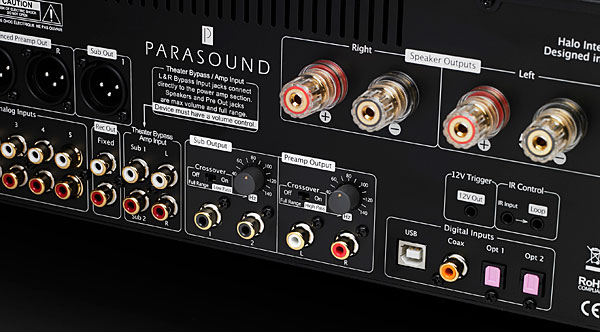
Beyond the noted hardware changes, the Halo Hint 6 remains mostly unchanged from the Halo Integrated. Both versions are 17.25" wide by 5.875" high by 16.25" deep and weigh 33 lb, have a class-AB output section delivering 160Wpc into 8 ohms, a discrete headphone amplifier and 3.5mm headphone jack, a 32-bit ESS Sabre32 DAC chip, five line-level RCA inputs, defeatable tone controls (!), a subwoofer output, and optical, USB, and coaxial digital inputs.
Listening . . .
Though I didn't have on hand a moving-magnet (MM) cartridge that I could use with the MM input of the Hint 6's revised phono stage, I did have four pairs of speakers that I figured would reveal any changes from Herb's assessment of the original Halo Integrated's easy-flowing personality.
I played three LPs on my Kuzma Stabi turntable with Stogi tonearm, running my Hana EL moving-coil cartridge into the Hint 6's MC input: Ella Fitzgerald's Ella Swings Brightly with Nelson (Verve V-4054); Noah Preminger's Some Other Time (Newvelle NV003LP); and Souvenir Part II: music for strings by Tchaikovsky and Nielsen, performed by the Trondheim Soloists (2L 2L-090C-LP).
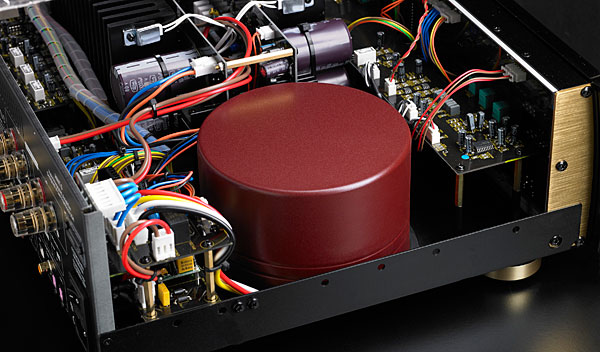
With Spendor Audio Systems A7s
The Spendor A7 ($4995/pair) demands power to burn. Given that power, it produces such razor-sharp images that I hoped to buy a pair—but I was concerned that it and the Halo Hint 6 would be a mismatch. Thankfully, they warmed to one other right away. The sound was anything but mellow with the Spendors' tweeters firing at ear level, but joined the Spendor's crispness to the Hint 6's wholeness and refinement. It almost felt as if I were leaning into the Trondheim Soloists' performance of Tchaikovsky's Serenade for Strings in C.
On his Some Other Time, Noah Preminger's tenor saxophone was downright creamy, with a warm burr that softened Billy Hart's mallet-generated cymbal crescendos. The treble seemed rolled off, but the overall sound was generous, even voluptuous. In "I Won't Dance," Ella Fitzgerald's big voice was rendered large, with the rhythm section, strings, and brass panned hard left and right. This combo made a devilishly good pair, sweet-toned but with serious jump and juice.
With DeVore Fidelity Orangutan O/93s
I hadn't played my reference speakers, DeVore Fidelity's Orangutan O/93s ($8400/pair), in a while, but when I drove them with the Parasound Halo Hint 6 I remembered how much I love them, and why I bought them many years ago. The big primates get it all right: a wide, realistically layered soundstage in my small den, spot-on tonality and texture, very good resolution, an almost genteel (tweeters below ear level) but propulsive low end, and a beautiful way with voices.
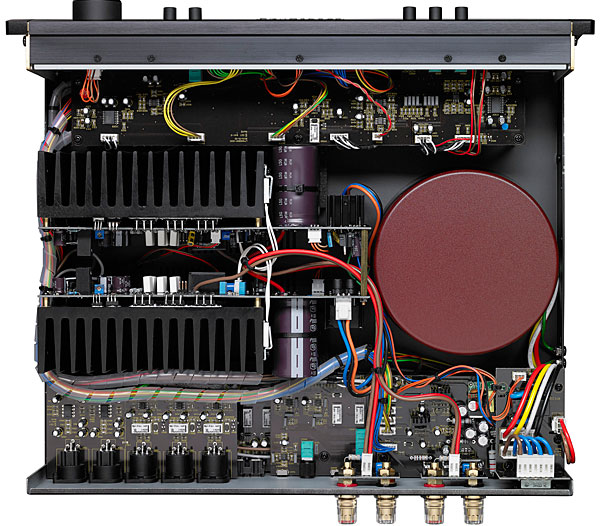
The Hint 6 let the O/93s shine. At almost twice the price of the Spendors, the DeVores produced a much fuller sound, with a deeper, broader soundstage. Drums had more kick. Ella Fitzgerald was in my ear, singing her subtle dynamic inflections for me and me alone. The Preminger disc became muscular and dynamic, sax and cymbals more visceral. Now, instead of sounding simply honeyed, the music vibrated and grooved. The Trondheim Soloists sounded less crystalline but somehow truer of tone. The strings were less separate and distinct, more massed together as a single organism. My emotional response remained undiminished.
The Hint 6 provided a level of control and nuance that the DeVore O/93s devoured. Both components were transparent, dynamic, always in service to the music.
With Quad S-2s
This mighty Quad stand-mounted model ($999/pair) has a ribbon tweeter and I was concerned lest the focused power of the Parasound Hint 6 kick it too hard. But while the soundstage was smaller than with the other speakers, the Parasound never pushed the Quads' ribbons into dangerous territory. Instead, music sounded brilliant and tangible, with a pulsating energy that made the strings of the Trondheim Soloists absolutely breathtaking. The sound was exhilarating. The Quads revealed the upper air of the Fitzgerald LP, with horns, hi-hat, and upper double-bass frequencies to the fore. And Preminger's tenor sax became less soft, more explicit and clean. The Halo Hint 6 enabled the Quads' drive and clarity and, ultimately, their altogether purposeful sound.
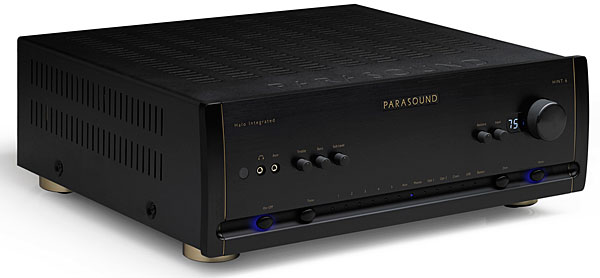
With Klipsch Heresy IIIs
Another speaker I truly love, Klipsch's Heresy III fat-boy floorstander ($1998/pair), provides the most fun you can have without going to jail, and for far less than the cost of a Better Call Saul–style attorney. I've yet to find an amplifier that couldn't cozy up to the Klipsches' 12" woofers and specified 99dB sensitivity and 8 ohm impedance, and the Parasound was no exception. This combo was magical. The leading edges of voices, tenor saxophones, and drums reached out to caress my ears. A joyous sense of upper-treble air made all music exhilarating, transparent, and fun. The splat, boom, and bam of Nelson Riddle's orchestra was off the chart. Ella seemed somehow goosed with extra propulsion and juice. And I felt I was hearing the Trondheim Soloists for the first time, their strings entirely chewy, rhythmic, and tactile, if lacking the more saturated color and refinement I heard through the DeVore O/93s.
Conclusion
Is Parasound's Halo Hint 6 Integrated Amplifier a party amp? A hard-rock enabler? A suave, swinging jazz proselytizer? It's all these things. The Hint 6 worked well with every speaker I threw at it, delivering an upfront, slightly cool, dynamic sound, LP after LP. Even at its higher price of $2995, the Halo Hint 6 offers good value in true Swiss Army knife fashion. I can't think of another integrated amplifier that offers so many options and has such solid, generous sound. Recommended.

... a wide variety of speakers, perhaps every Stereophile reviewer should own one of these amps to serve as a fixed point of reference when reviewing other equipment.

was a terrible combo in my experience. The bass became overbearing and bloated. The horn coloration seemed to increase two-fold. I can't imagine the Hint 6 differs enough from the original that it makes for a good partnering.
Even so, it's nice to read a review of an affordable integrated from someone other than HR for a change.

PS Audio Stellar pre-amp + Stellar stereo amp are also in this power and price range :-) ........

This seems to be light on for a JC designed amp in current department, will be interesting if JA does bench tests to see if these are for real as well, and to see what they show up.
Power output:
160Wpc into 8 ohms
270Wpc into 4 ohms
Cheers George

"Both versions ... have ... defeatable tone controls (!)..."
I guess the exclamation mark is appropriate given how few amps have tone controls. I, and other listeners, would love to see more.
But not all tone controls are equal. JA's measurements for the earlier version of this Parasound show tone controls that, when boosted, reach their maximum values only at the extreme ends of the audible spectrum. The sad result is that you don't really get any audible boost in bass or treble (i.e., the mid-bass or mid-treble); you only get deep subterranean one-note thumping in the sub-bass, and unpleasant hiss and brightness in the treble. Some manufacturers are so concerned with "keeping the tone controls out of the all-important midrange" that they become useless.
Bass and treble controls as implemented by NAD or Outlaw Audio(see Stereophile measurements) produce a much more pleasant listening experience and a much more useful, and musical, result.

One of the features missing in many of these integrated amps and many pre-amps is a 'processor loop' ...... That would be useful for an add-on external EQ unit ....... Such an external unit would be useful for the main speakers, as well as the headphone output and the subwoofer(s), in the HINT-6 :-) ........
As a side note ...... McIntosh makes several pre-amps, integrated amps/receivers with built-in, bypass-able tone controls, 5 and 8 band parametric EQ ......... McIntosh units are more expensive, but most are under $10k :-) ..........
Rogue Audio also provides 'processor loop' in some of their pre-amps and integrated amps under $5k :-) .......

BTW ...... that is a 'hint' :-) .........

This Parasound model does indeed have one.

Thanks ...... I missed that :-) .........

I wonder how the new version sounds differently from the original?

Re: your question, , my understanding is that, other than improved crosstalk, the HINT & HINT 6 sound nearly identical. Most of the HINT6 improvements are cosmetic -- perhaps in part to justify the price increase?
Me, I'm looking for guidance re: whether the HINT6 is a better choice than Peachtree's similar nova500 for a Harbeth-based system. The only nova review in Stereophile (or TAS) was a nova300 review that was controversial to the point of being inconclusive. Despite Parasound's consistently positive reviews, the nova500 (a significant circuit upgrade from the 300) has broader functionality than either HINT, including WiFi, a much better DAC, and 3 times the power. Because it's often discounted, the 500 is also at least a few hundred bucks cheaper. Harbeth tells me that, despite officially published specs, 300-500 wpc provides the best dynamics with even its smallest speakers, so I'm tempted to go Peachtree over Parasound. But, jeez, without ever hearing either unit? -- the nearest high-end store is a half-day plan trip away. Has anybody actually compared the two in person?

I have the original Hint and the newer Klipsch Heritage Heresy Iv. It is indeed a winning combination. I am enjoying pulling out all of my music to hear it on this combo, with great results. My room is 13 by 16 (that extends to 30 feet with pocket doors open) with an 8 foot ceiling. I have moved the sub into my basement home theater room, as it is no longer needed upstairs. I believe the biggest difference in the updated integrated is a newer DAC chip. But I am very content with this investment. It's all good.